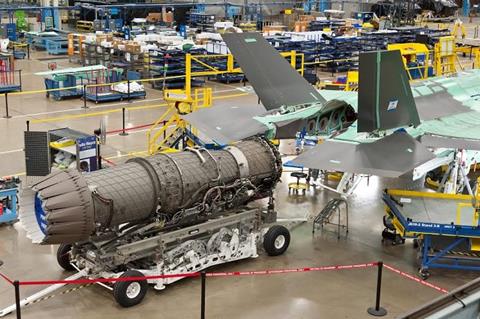The Pentagon is reaffirming its commitment to delivering an engine upgrade for the Lockheed Martin F-35 stealth fighter.
Propulsion supplier Pratt & Whitney on 30 September received a $1.3 billion contract from the US Department of Defense (DoD) to continue development work on the Engine Core Upgrade (ECU) for company’s F135 turbofan, which powers the F-35.
The latest contract will fund design, analysis, rig testing, engine test preparation, developmental hardware, test asset assembly, air system integration, airworthiness evaluation and product support planning to further maturation of the ECU system, according to the Pentagon.

“This contract is critical to continuing our positive forward momentum on this programme,” says Jill Albertelli, president of P&W’s military engines business. “It allows us to continue work in the risk reduction phase with a fully staffed team focused on design maturation, aircraft integration and mobilising the supply base to prepare for production.”
P&W says it has more than 700 personnel working on the ECU programme. The company has previously said it is targeting a service entry date of 2029 for the improved engine core, which is compatible will all three F-35 variants.
The goal of the ECU programme is to improve the capacity of the F-35’s existing single engine to provide electrical power and cooling to onboard systems. In conjunction with the Honeywell Power and Thermal Management System, the F135 keeps essential aircraft systems operating, including weapons, fire control radar, communications and life support.
However, subsequent capability improvements to the jet have pushed the F135 to operate outside the original design specifications. While P&W says this is not a threat to the F-35’s flight performance, it does produce extra wear and tear on the engine, resulting in more frequent overhauls and higher sustainment costs.
The ECU was seen as a more cost-effective way to address the power and colling shortfall, with the alternative being an entirely new engine. P&W rival GE Aerospace unsuccessfully pushed for this option, with the Pentagon formally opting for the ECU in 2023.
While the US Air Force was initially in favour of a new engine, concerns about cost and compatibility with the short take-off and vertical landing F-35B from the US Navy and US Marine Corps ultimately steered the DoD toward an upgrade of the existing propulsion system.
All three US military operators of the F-35 are now set to field the improved powerplant.
P&W says the ECU package can be installed at Lockheed’s F-35 assembly line for new jets or at F135 maintenance depots for the existing fleet.































